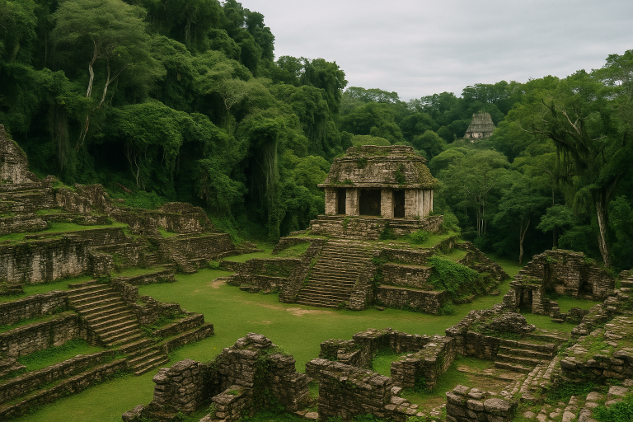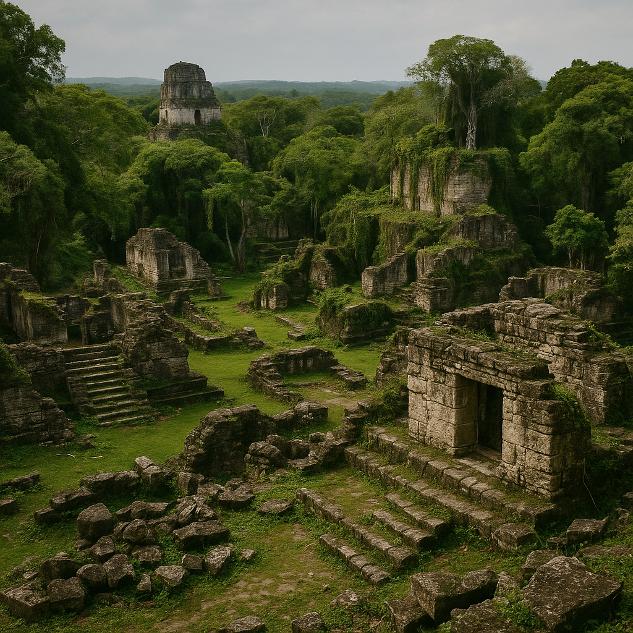
In This Article
- How did environmental mismanagement contribute to the fall of ancient civilizations?
- What are the parallels between historical and modern ecological collapse?
- Why are today's elites possibly cognitively compromised?
- How are the lower classes defending the system harming them?
- What must change to avoid repeating history's collapse?
Civilizational Collapse Is a Process, Not an Event: Lessons from History's Fall
by Robert Jennings, InnerSelf.com
We often imagine the fall of civilizations as sudden and cataclysmic. Rome was sacked. The Maya vanished. Easter Island went silent. But collapse, in truth, rarely arrives with a bang. It creeps. It erodes. It begins with overlooked cracks, repeated mistakes, and decisions that seem inconsequential—until they’re not. History’s greatest civilizations didn’t fall because they were conquered in a single day. They lost because they ignored the signs for generations, a fate that seems inevitable when we look at the patterns of history.
And here’s the haunting part: many of those signs were environmentally caused by humans.
For the longest time, humanity could claim ignorance. Ancient rulers didn’t understand the limits of soil fertility, the consequences of deforestation, or the dangers of tainting water sources with metals. They overgrazed their fields, diverted rivers, and cut down forests without knowing they were undermining the ground they stood on—literally and metaphorically. It was our actions that led to these environmental signs, and we might have blamed the gods or unlucky stars when famine hit, or the rains failed. Today, we know better.
We are the first global civilization to peer into the abyss with full awareness. We have supercomputers modeling climate chaos. Satellites tracking shrinking ice caps in real-time. Peer-reviewed science detailing the effects of air pollution, plastic toxins, biodiversity loss, and rising seas. Our modern knowledge empowers us to understand the current crisis. Entire conferences and accords are dedicated to environmental preservation. And yet—despite all this—we continue marching toward the same endgame that toppled empires before us.
This is not just a warning. It’s a pattern. The collapse echoes follow a familiar rhythm from Sumer to Rome to the Maya. A civilization flourishes, expands, and becomes overconfident. It exploits its environment to fuel further growth. It ignores early signs of strain. And when the cracks deepen, it doubles down—investing in symbols of power rather than solutions. When the elite realize the center can no longer hold, the periphery is already gone, the food systems are failing, and the people have turned against them.
But what if those ancient collapses didn’t just coincide with environmental failure? What if ecological stress was the catalyst—the final nudge that sent already unstable systems over the edge? And what if we’re experiencing the exact tipping point today, only with more complexity, more knowledge—and more to lose?
In this article, we’ll revisit the collapses of ancient civilizations—not as distant history, but as cautionary blueprints. We’ll explore how environmental mismanagement, elite arrogance, and systemic fragility combined to unravel the world’s most extraordinary powers. Then we’ll bring it home: what does that mean for us, here, now, in the twenty-first century, as we face our gathering storm? And most urgently—what role do today’s elites and power structures play in accelerating the unraveling?
This isn’t just about the fall of civilizations. It’s about the choices that lead there—and the warnings we still have time to heed. By learning from the collapses of ancient civilizations, we can avoid repeating their mistakes and make the necessary changes to prevent a similar fate.
Environmental Collapse as a Catalyst
To understand how civilizations collapse, we have to let go of Hollywood images—of swords clashing, cities burning, and empires falling overnight. The reality is much slower, subtler, and far more insidious. Civilizations don’t usually die from conquest; they die from internal exhaustion, ecological overshoot, and the steady decay of systems they thought were eternal.
What ties so many fallen civilizations together isn’t just war or bad luck—it’s a pattern of environmental mismanagement coupled with political and social blindness. These ancient societies reached a tipping point where they had exceeded the carrying capacity of their environment, a concept known as 'ecological overshoot'. And just like today, the warning signs came early and were ignored.
The Maya: Deforestation and Drought
The Mayan civilization spanned hundreds of years, and magnificent cities were built in what is now southern Mexico, Guatemala, and Belize. Their society was a marvel of astronomy, architecture, and agriculture for centuries. But beneath the temples and calendars was a fragile ecological foundation.
The Maya deforested large swaths of land to support growing populations and elite lifestyles. Trees were cut to clear farmland and fuel limestone kilns used in building their cities. Over time, this led to severe soil erosion. Compounding the damage, they modified wetlands and built water reservoirs that required constant upkeep. When a series of prolonged droughts hit—now confirmed by lake sediment studies—the system buckled. Agricultural collapse led to famine, unrest, and, eventually, the abandonment of major cities.
The fall of the Maya was not instant. It came in waves over decades as city-states declined one after another. The elite clung to rituals and built even grander monuments in the face of crisis—perhaps hoping to signal strength while the foundation crumbled beneath them.

Sumer and Mesopotamia: Salting the Earth
The Sumerians, who inhabited southern Mesopotamia (modern-day Iraq), are credited with building one of the first complex civilizations in human history. They developed irrigation agriculture to sustain large cities like Uruk and Ur. But their irrigation systems, while innovative, had an unseen consequence: they slowly salted the Earth.
Without proper drainage, water from the Tigris and Euphrates rivers evaporated, leaving salt in the soil. Over centuries, this reduced crop yields and forced a shift from wheat to more salt-tolerant barley—until even that failed. What had once been a breadbasket turned into a barren plain? Political fragmentation followed as cities competed for dwindling resources. The Akkadian Empire, which briefly united the region, collapsed around 2200 BCE—likely due partly to a combination of drought and salinization.
This was not ignorance in the modern sense. The Sumerians didn’t have modern soil science—but they could observe declining harvests. Their failure lay in repeating the same mistakes, locked in a system that demanded more food, water, and growth, even as nature pushed back.
Rome: Luxury, Lead, and Exhaustion
The fall of Rome is often framed as the work of barbarian invasions or political decadence. But beneath the political narrative is a deeper ecological story. Rome’s agricultural system was overextended. Centuries of conquest brought in grain from North Africa and Egypt, but closer to home, Roman soil had been depleted by overfarming and deforestation. Erosion and falling productivity made the empire increasingly reliant on imported food and slave labor.
And then there was the lead. In their pursuit of luxury, the Roman elite piped water into their villas using lead plumbing. They sweetened wine with sapa, a syrup made by boiling grape juice in lead vessels. While the common people drank from public fountains fed by stone aqueducts, the rich were exposed to slow, steady poisoning. Modern analysis shows elevated lead levels in Roman skeletons and drinking water sediments, especially in elite urban centers.
Lead affects cognition, impulse control, and reproductive health. It doesn’t take much imagination to draw a line from this to the erratic behavior of later Roman emperors, the collapse of effective leadership, and the increasing inability of the ruling class to adapt to crisis. This is not to say lead caused the fall of Rome, but it may have catalyzed a decline in decision-making quality at the very top.
Easter Island: The Edge of Isolation
Perhaps no civilization better symbolizes environmental overshoot than Rapa Nui—Easter Island. Isolated in the Pacific, the people of Easter Island built a remarkable culture around giant stone statues (moai). To move and erect these statues, they cut down trees to create transport systems and to support agriculture and construction.
Over centuries, they almost entirely deforested the island. Without trees, they couldn’t build canoes, hunt efficiently, or maintain soil fertility. The ecosystem collapsed, and so did the population. Archaeological evidence shows a dramatic decline, starvation, and even signs of cannibalism in later stages. By the time Europeans arrived in the 18th century, the island’s society had fragmented into rival clans fighting over scraps of a once-thriving culture.
Easter Island is often used as a parable. It was a closed system, and its people used up their resources faster than they could be replenished. Sound familiar?
The Ancestral Puebloans: Drought and Displacement
In the U.S. Southwest, the Ancestral Puebloans (also called the Anasazi) built cliff dwellings and irrigation systems in places like Chaco Canyon. Their society depended on predictable rainfall and a delicate balance with the arid land. When prolonged droughts struck in the 12th and 13th centuries—confirmed by tree-ring data—their fields failed, trade networks broke down, and people migrated away from centralized sites.
What followed wasn’t total collapse but transformation. The centralized culture gave way to smaller, dispersed communities. Yet the loss of cohesion and culture marked the end of an era—a collapse not of humanity but of a way of life that had once thrived.
The Pattern Behind the Fall
Across all these civilizations, the pattern holds: environmental degradation, driven or accelerated by human choices, creates stress that institutions are too rigid or corrupt to respond to. Elites double down instead of reforming. The gap between those at the top and those on the margins widens. And when nature finally demands repayment, the system lacks the flexibility, humility, or solidarity to withstand the shock.
Collapse isn’t always a sudden end—it’s often a slow death masked by spectacle. The Maya kept building monuments, Rome kept having games, and Easter Island kept carving statues. And each time, it looked like the culture was thriving—until it wasn’t.
So what happens when a modern, global civilization—armed with science, data, and foresight—begins to walk the same path?
Today’s Environmental Triggers
We live in an age of miracles—clean water from a tap, electricity at the flick of a switch, and food from around the world delivered in a day. But underneath the surface of this modern miracle is a foundation as brittle as the one that once held up the Roman aqueducts, the Mayan reservoirs, or the Mesopotamian fields. And like those ancient empires, our civilization is approaching its own tipping points, many of which are environmental and man-made.
Today’s world does not face one environmental crisis. It faces a web of them, all unfolding simultaneously and reinforcing one another. Unlike past civilizations that collapsed under the weight of one or two ecological missteps, we are the first to face global collapse potential—across climate, soil, water, air, and biodiversity—at a planetary scale.
Take climate change. It is no longer just a scientific projection; it’s a daily headline. Wildfires torch landscapes that once burned every century. Droughts stretch across continents. Oceans rise and heat, with coral reefs dying by the square mile. Storms grow stronger. Floods are more frequent. Entire towns, even nations, are on the verge of becoming uninhabitable.
But climate is only the beginning. Our soil—the foundation of agriculture—is being destroyed at a rate far exceeding its natural regeneration. Industrial farming, monocropping, and chemical fertilizers strip it of nutrients and life. The United Nations has warned that fewer than 60 harvests may be left in much of the world’s arable land. No soil, no food. It’s that simple.
Water, too, is vanishing. Aquifers that took millennia to fill are being drained in decades. Rivers like the Colorado and Ganges no longer reach the sea in some years. Glaciers that provide seasonal meltwater for billions are shrinking. And all of this is happening while the population—and demand—grow.
We’re poisoning ourselves, too. Microplastics have been found in human blood, breast milk, placentas, and clouds. PFAS chemicals—called “forever chemicals”—are in the rainwater of every continent. Heavy metals, pesticides, and industrial toxins flow freely through rivers and food chains. These aren’t distant threats; they’re already in us, shaping everything from cognitive development to fertility to cancer rates.
Biodiversity loss may be the quietest collapse, but it could prove catastrophic. One million species face extinction, pollinators like bees are vanishing, and fisheries are being pushed beyond recovery. Every lost species is a thread pulled from the web of life that keeps our ecosystems stable. At some point, the whole net gives way.
And yet, with all this knowledge—with more data, sensors, models, and warnings than any civilization in history—we are doing little to change course. In some cases, we’re accelerating toward collapse.
From Ignorance to Willful Blindness
The rulers of Rome did not know they were being poisoned by lead. The Sumerians likely did not understand the long-term effects of irrigation on soil salinity. The people of Easter Island may not have realized that the last tree had a cost until it was too late. They acted in ignorance, within the limits of their understanding. Can we say the same?
We cannot, and that changes everything. What separates our civilization from theirs is not just technology or scale—it’s awareness. We know what we are doing. We’ve been told. The science is not hidden. The reports have been written. The images are public. The effects are being lived right now by millions.
And yet, the structure of modern power—especially since the ideological shift of the 1980s—makes meaningful action nearly impossible. The so-called Reagan Revolution rewired the global economy. Deregulation, privatization, and the dogma of market supremacy stripped governments of their ability to act boldly. Climate denial wasn’t just a fringe idea—it was a policy platform underwritten by fossil fuel giants, amplified by corporate media, and enforced through think tanks and lobbyists.
This wasn’t just neglect. It was designed. Climate scientists were warning governments in the 1970s and 80s. Exxon’s own internal documents predicted global warming with chilling accuracy. And what did those in power do? They buried the evidence, smeared the messengers, and doubled down on carbon-intensive growth. What could have been a course correction in the 20th century became a locked-in catastrophe by the 21st.
The result is a civilization that knows it's poisoning itself but is structurally incapable of stopping. Every political cycle is shorter than the climate timeline. Every shareholder report values quarterly gains over planetary survival. Every solution is moderated, watered down, or turned into a marketing scheme. Carbon credits are traded like Monopoly money. Greenwashing replaces action.
Even among those who mean well, the scale of the crisis breeds paralysis. People recycle, while mega corporations dump tons of plastic into oceans. Individuals install solar panels while oil subsidies persist. The system tells us to feel guilty for using straws while it lays pipelines across sacred lands and burns forests for profit.
This is not ignorance. It’s willful blindness—sustained, cultivated, and enforced by those most benefit from the status quo. The ancients had excuses. We have none.
And yet, the system is not just failing from the top down. The most dangerous shift may not be technological or ecological but psychological. As environmental decay accelerates, so too does the decay of empathy, foresight, and solidarity. This is where the parallels with ancient Rome grow darker.
What happens when the ruling class, knowing full well what lies ahead, still chooses inaction? What happens when the lower classes, increasingly disillusioned and dispossessed, become susceptible to authoritarianism, scapegoating, and violence? What happens when collapse is not just physical but mental and moral?
We’ve inherited all the tools needed to survive this moment—science, cooperation, knowledge. But our institutions are hollow, our leadership compromised, and our culture trained to look away. Collapse isn’t creeping anymore. It’s speeding up. As the next section will explore, the people entrusted with protecting civilization may be the least capable of doing so because they, like Rome’s elite, may already be poisoned by the system they built.
Elite Degradation as a Feedback Loop
History shows us that collapse doesn’t come solely from the outside. It comes from within—from the erosion of judgment, the decay of empathy, and the loss of foresight among those in power. When societies hit environmental limits, they don’t necessarily die. But when the ruling class can no longer respond with wisdom or restraint, the cracks become irreversible. This is the heart of what we’ll call a Catalyst Theory—the idea that environmental breakdown doesn’t just affect the physical world. It reshapes behavior, warps institutions, and weakens the minds of those in charge. And in doing so, it acts as a spark that accelerates the decline.
Take Rome. For years, historians debated whether lead poisoning contributed to the empire’s collapse. While the theory isn’t the whole story, the evidence is telling. The elite were disproportionately exposed to lead through pipes, cookware, and wine. Modern studies of Roman skeletal remains and plumbing sediments show elevated levels of lead—enough to affect cognition, fertility, and emotional regulation. It’s not hard to see how a ruling class slowly losing its mental sharpness and impulse control might struggle to manage a sprawling empire under stress.
Now fast-forward to today. The idea of poisoned elites sounds dramatic—until you look at the data. We are awash in environmental toxins. PFAS (so-called “forever chemicals”) are in the bloodstream of nearly everyone on Earth, including unborn children. Microplastics have been found in human lungs and brains. Endocrine-disrupting chemicals in plastics and pesticides are linked to cognitive delays, reduced sperm counts, rising infertility, and behavioral disorders. Heavy metals like mercury, cadmium, and arsenic contaminate water and food sources worldwide.
The very people making decisions about the future—CEOs, politicians, financiers, tech barons—aren’t exempt. If anything, they live in environments with exposure risks: high-end diets filled with industrial seafood, plastic-packed convenience, and tech-heavy urban spaces rife with pollutants. Like Rome’s elite, modern powerbrokers may be subject to slow, cumulative neurological degradation—not enough to be noticed daily, but enough to shift behavior over time.
But there’s another layer: social inbreeding. Not entirely genetic, necessarily, but intellectual and experiential. Today’s elites attend the same few universities, marry within the same circles, and are embedded in echo chambers of ideology and wealth. This kind of cognitive monoculture breeds rigidity. It selects those who can navigate the system as it exists, not those who challenge it. Over time, this creates a class that is not just out of touch with reality but also incapable of adapting to it.
And what does our system reward? Not empathy, humility, or reflection. It rewards aggression, narcissism, short-term thinking, and public relations optics. It creates leaders trained to win at the game, not to question whether the game is broken. In the marketplace of modern power, the sociopath often beats the visionary. That’s not biology—that’s incentive design. However, incentives shape behavior, and behavior becomes culture.
This feedback loop—where environmental damage affects leaders' minds, and those minds then make more damaging decisions—may be the true catalyst of modern collapse. It explains why, despite decades of warnings, our most powerful institutions fail at even the most basic environmental protections. It explains why leaders still stall, spin, and sell false hope in the face of overwhelming evidence. It’s not just corruption. It’s a neurological and cultural hardening—a civilization-wide arteriosclerosis of the mind.
What makes this even more dangerous is that those outside the elite bubble—those suffering the most from environmental collapse—are increasingly weaponized to defend it. As we’ll explore in the next section, a poisoned elite is only half the story. The other half is the disillusioned public, manipulated into rage, division, and scapegoating. When the ruling class can no longer lead and the people can no longer trust, what’s left isn’t democracy or reform. It’s collapse.
So, the question isn’t whether today’s elites are malicious or foolish. The deeper question is whether they are still biologically, cognitively, and culturally capable of doing what this moment demands. We’re not looking at a leadership crisis if the answer is no. We’re looking at a civilization entering a terminal feedback loop—just like Rome, the Maya, and every society that mistook decadence for stability until the ground fell out beneath them.
The Paradox of the Poisoned Lower Class
While the ruling class may be eroding from within, the lower classes now bear the brunt of environmental collapse—and, paradoxically, are often the ones defending the very systems accelerating it. This is the excellent and tragic reversal of history. In ancient Rome, the elites were poisoned by lead while the ordinary people drank from public fountains. Today, the opposite is true. In addition to the exposure of the elites, the poor breathe the worst air, drink the dirtiest water, and eat the most contaminated food. They live near highways, factories, and landfills—not gated communities and filtered estates.
It’s no secret that environmental hazards concentrate in the poorest zip codes. In the United States alone, neighborhoods of color and low-income communities are disproportionately exposed to lead, industrial runoff, pesticide drift, and air pollution. From Flint, Michigan, to Cancer Alley in Louisiana, the people suffering the most from ecological damage are those least empowered to stop it—and, increasingly, those most likely to support leaders who promise not to fix it but to fight a cultural war.
How did this happen?
The answer lies in decades of deliberate manipulation. As environmental degradation deepened and economic inequality widened, the institutions that once fostered solidarity—unions, civic groups, churches—were gutted. Into that vacuum rushed disinformation, tribalism, and grievance politics. Powerful interests redirected public anger away from polluters and toward imagined enemies: immigrants, minorities, scientists, and coastal elites.
It’s no accident that the same working-class towns hollowed out by globalization and poisoned by industrial neglect are now bastions of populist rage. The system failed them repeatedly. Their jobs disappeared, their hospitals closed, their water turned toxic—and the only people who showed up, rhetorically at least, were demagogues offering someone to blame. Not the oil companies. Not the billionaires. But the activists, journalists, and academics who were trying—however imperfectly—to raise the alarm.
This is the paradox: the people most harmed by environmental collapse have become its most passionate defenders—not because they want collapse, but because they’ve been led to believe that admitting the system is broken means surrendering everything else they value: identity, pride, history, and control. Collapse, for them, is not the fear—it’s the lived reality. They fear replacement, shame, and the unknown future they’ve been told awaits if the “green agenda” wins.
In this way, the poisoned elite and the public form a tragic alliance. One cannot lead. The other cannot trust. And between them is a world teetering on the edge. It’s not just that collapse is coming—it’s that collapse has found defenders among its victims. And when that happens, the feedback loop tightens. Solutions become threats. Warnings become insults. And reality itself becomes the enemy.
Are We Rome, or Are We the Ones Who Learn?
Every civilization that has collapsed left behind warning signs. The Maya left empty cities swallowed by the jungle. The Sumerians left salinized soil that could no longer grow food. Rome left ruins, lead pipes, and a legacy of squandered power. Each of these cultures believed in their own permanence until their systems could no longer bend and finally broke.
But unlike those who came before us, we do not live in ignorance. We cannot pretend that we don’t see this coming. The science has spoken, the data is overwhelming, and the signs are visible in every flood, fire, heatwave, and failed harvest. What we face now is not a lack of knowledge. It is a lack of courage, a deficit of will, a surrender to inertia dressed up as pragmatism.
And that may be the most tragic echo of all. We have the tools to avert collapse. We have the technology, the science, the resources, and the global reach to make sweeping changes. We can decarbonize economies, regenerate soil, protect biodiversity, and clean water systems. What we lack is leadership that’s intact, institutions that are uncorrupted, and a collective story that places survival above spectacle.
So we must ask ourselves honestly: Are we Rome, building monuments as the empire fractures? Are we Easter Island, carving statues to distraction while the last tree falls? Or are we something new—something history has not yet seen—a civilization willing to learn from its ancestors before the final chapter is written?
The answer depends not just on governments or billionaires but on us. It depends on whether we continue to look away, numbed by crisis fatigue, or whether we face the truth and demand a new path. It depends on whether we continue to place our faith in systems that are failing us or whether we begin building new ones grounded in resilience, cooperation, and reverence for life.
Collapse is not inevitable, but it is close. We can still turn the wheel, but not with minor reforms or PR campaigns. It will take systemic transformation and cultural awakening—one that refuses to normalize dysfunction, refuses to reward delay and refuses to accept the story that nothing can be done.
This is the final lesson of the civilizations that came before us: that nature is patient but not infinite. That system can endure a thousand cuts until one becomes fatal. That the failure to act is itself a choice—a choice that history will neither forgive nor forget.
We are not doomed to repeat the past. But we are echoing it. The question is whether we will listen—to the ruins, the science, to each other—before we become the next whisper in the long story of collapse. Or perhaps the end of human existence is our final trial, given the potential of global warming.
About the Author
 Robert Jennings is the co-publisher of InnerSelf.com, a platform dedicated to empowering individuals and fostering a more connected, equitable world. A veteran of the U.S. Marine Corps and the U.S. Army, Robert draws on his diverse life experiences, from working in real estate and construction to building InnerSelf with his wife, Marie T. Russell, to bring a practical, grounded perspective to life’s challenges. Founded in 1996, InnerSelf.com shares insights to help people make informed, meaningful choices for themselves and the planet. More than 30 years later, InnerSelf continues to inspire clarity and empowerment.
Robert Jennings is the co-publisher of InnerSelf.com, a platform dedicated to empowering individuals and fostering a more connected, equitable world. A veteran of the U.S. Marine Corps and the U.S. Army, Robert draws on his diverse life experiences, from working in real estate and construction to building InnerSelf with his wife, Marie T. Russell, to bring a practical, grounded perspective to life’s challenges. Founded in 1996, InnerSelf.com shares insights to help people make informed, meaningful choices for themselves and the planet. More than 30 years later, InnerSelf continues to inspire clarity and empowerment.
Creative Commons 4.0
This article is licensed under a Creative Commons Attribution-Share Alike 4.0 License. Attribute the author Robert Jennings, InnerSelf.com. Link back to the article This article originally appeared on InnerSelf.com
Article Recap:
Civilizational collapse is unfolding through a web of environmental decline, elite inaction, and systemic fragility. From ancient warnings to modern crises, the signs are clear. Whether we break the cycle or repeat it depends on the choices we make now.
#civilizationalcollapse #environmentaldecline #climatecrisis #systemiccollapse #ecologicalwarning



